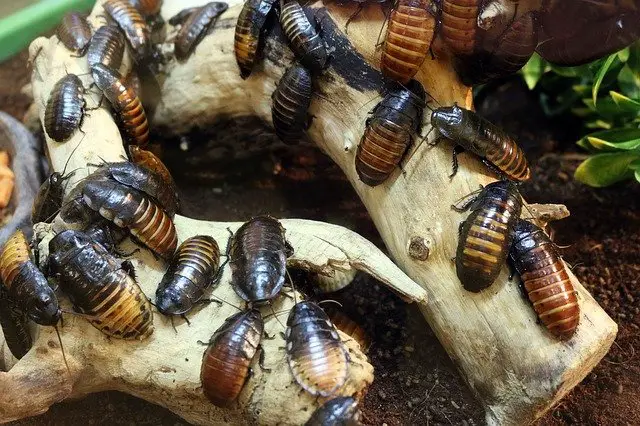If you’re an owner of one of these incredible amphibians, you may be wondering the answer to this question. In short, the answer is yes, but there are quite a few things you’ll want to know before adding these insects into their diet.
Can Red-Eyed Tree Frogs Eat Dubia Roaches
Red-eyed tree frogs are opportunistic eaters and will consume a variety of insects, including dubia roaches.
Dubia roaches are a type of cockroach often used as feeder insects for reptiles and amphibians.
They are a good source of protein and essential nutrients, making them an ideal food for red-eyed tree frogs.
In the wild, red-eyed tree frogs typically eat dubia roaches that are between 1/2 and 1 inch in size. However, captive red-eyed tree frogs can be offered larger dubia roaches as well. It is essential to provide your red-eyed tree frog with a varied diet to ensure they receive all the nutrients they need to stay healthy.
In addition to dubia roaches, you can offer them crickets, mealworms, and other small insects.
Red-Eyed Tree Frogs
Red-eyed tree frogs are arboreal amphibians, meaning they tend to live amongst the trees and other tall leafy plants. Their lifespan in captivity averages about eight years, while their average lifespan in the wild is about ten years. At full maturity, the red-eyed tree frog measures only 2 – 3 inches in size. Females are typically larger than their male companions. However, their sizes can always vary.
Dubai Roaches
Dubia roaches are medium-sized cockroaches typically found in the Central and Southern American regions. These insects reach between 1.5 – 2 inches at full maturity and are commonly used as feeder food for many reptiles, amphibians, birds, and fish.
A Natural Comparison
Red-eyed tree frogs and dubia roaches originate from the same regions of the world, preferring warmer temperatures and medium humidity levels. Knowing this, it could be easy to assume that red-eyed tree frogs would like dubia roaches as the primary source for their diet. However, this is not the case.
Most animals typically prey on smaller creatures for their food source, so while red-eyed tree frogs can eat dubia roaches in the wild, they usually won’t. Smaller insects are easier for amphibians to digest, so red-eyed tree frogs are more likely to eat crickets, flies, and moths.
The Proper Diet of a Red-Eyed Tree Frog in Captivity
Red-eyed tree frogs are predatory creatures that feed on insects throughout their lifespan. In captivity, crickets are the primary source of this amphibian’s diet. Dubai roaches, hornworms, and silkworms can also be fed occasionally but should never be a primary food source.
While red-eyed tree frogs typically don’t eat any greens on their own, it’s always recommended to gut-load your feeder insects with fresh veggies and supplements to help naturally introduce other nutrients into their diet.
On the Side of Caution
While dubia roaches can be fed to your red-eyed tree frog, you should do so with caution.
Dubai roaches contain uric acid, which can be harmful to your red-eyed tree frog, causing kidney problems and gout over time. Gout is a form of inflammatory arthritis that can cause severe pain and tenderness in joints. The uric acid in dubia roaches is caused by a high protein diet but can be controlled if the insects are adequately fed.
The Proper Diet for Dubia Roaches as a Feeder Insect
When planning to feed your red-eyed tree frog any dubia roaches, you’ll want to ensure the diet they have been provided is healthy.
If you’re buying dubia roaches from another source, it’s essential to see what diet the insects have been fed. Unfortunately, not all bases of dubia roaches are willing to share this information, so the best way to make sure that your cockroaches are on a proper diet is to raise them yourself.
The best diet for dubia roaches is a low-protein diet. This helps to keep uric acid levels low and stops the bugs from rapidly growing and becoming too large. This diet should consist of various plant-based foods, like fruits and vegetables. Selecting fresh organic produce is also very important as you don’t want to have any lingering pesticides from the foods transferred to your roaches.
Some foods to avoid feeding dubia roaches are citrus, meat, and beans. It also may sound a bit crazy, but some people feed their roaches cat or dog food, which is exceptionally high in protein and is a terrible option. Wheat and oats are also familiar food sources for dubia roaches, and these are okay because they are low in protein, but it’s always best to mix them up with more fresh produce.
The Right Way to Feed Dubia Roaches
Dubia roaches shouldn’t be fed to your red-eyed tree frog more than once a week. Since dubia roaches can be almost as giant as your red-eyed tree frog, you’ll want to feed them only when they are small. It is recommended that the bugs should be no larger than the length between the frog’s eyes.
A little also goes a long way, so when you feed your frog the roaches, provide only one or two for that feeding time.
The diet of your red-eyed tree frog is vital for keeping it healthy and allowing it to live a whole life. As long as you can follow this information, you should be safe in occasionally feeding dubia roaches to your amphibious companion.





